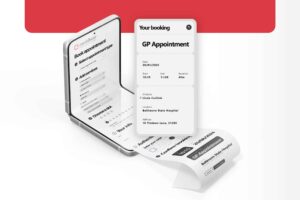For years, healthcare has moved slowly. Systems are clunky, records are scattered, and patients often feel like they’re waiting on both answers and access. But the script is changing. Technology is stepping in, not just to modernize processes, but to rethink how care is delivered.
AI is speeding up diagnostics. Wearables are turning patients into daily data sources. Telehealth is closing the distance between providers and the people they serve. And tools that once sounded futuristic are quickly becoming standard. The result is care that feels more personal, more efficient, and more responsive. But this transformation is not just about machines or algorithms. It is about people. The tools may be digital, but the goals remain human: better outcomes, smarter systems, and a healthcare experience that meets patients where they are.
Let’s take a look at what is changing and what it could mean for the future of care
Cloud Integration in Healthcare: Building a Smarter, More Connected System
Cloud computing is increasingly essential in healthcare administration, facilitating secure and easy-to-access patient data management. Unlike traditional on-premise systems, cloud-based platforms offer scalable, secure, and flexible infrastructure that adapts to the evolving needs of healthcare organizations, without the constant headache of maintaining outdated servers or managing physical storage. It is predicted that by the end of this year, up to 95% of healthcare organisations will be using cloud services for patient data management, one of the clearest advantages of cloud integration. With electronic health records (EHRs) stored securely in the cloud, authorized healthcare professionals can retrieve and update patient information in real time, from virtually any location. This not only improves communication among care teams but also supports faster, more informed clinical decisions.
Security remains a top priority, and modern cloud providers offer great safeguards, such as encryption, access controls, and regular audits, to ensure compliance with healthcare regulations like HIPAA. With built-in disaster recovery and data backup systems, cloud platforms also help mitigate the risk of data loss due to hardware failures or cyberattacks.
From Record-Keeping to Practice Management: The Evolution of EHR Systems
EHRs have come a long way from their early role as passive digital archives. Initially designed to replace paper charts, EHRs served as centralised databases for patient medical histories, lab results, prescriptions, and visit notes. But over the past decade, EHRs have evolved into far more than storage solutions as they now function as comprehensive practice management platforms.
Modern EHR systems bring together a wide range of administrative and clinical tools directly into their interfaces. Appointment scheduling, billing, coding, insurance verification, and even inventory tracking can now be handled within a single system. This improves daily operations, reduces the need for multiple disconnected software solutions, and minimises the risk of errors caused by redundant data entry.
More importantly, today’s EHR platforms are built to enhance workflow efficiency. Customisable dashboards and automation tools allow healthcare providers to personalise their systems based on specialty, patient load, and administrative structure. For example, automated billing tools can instantly generate claims based on documented services, while integrated messaging systems support secure communication between clinicians, staff, and even patients.
AI and Automation: Reducing Administrative Tasks
Artificial Intelligence is often spoken about as if it’s some distant, futuristic concept, but in healthcare administration, it is already doing very real and practical work. It is not here to replace people. It is here to handle the bits of the job that are repetitive, time-consuming, and frankly a bit dull.
Many healthcare organisations are using AI tools to manage tasks like appointment scheduling, billing, data entry, and reminders. These systems can process information quickly, reduce human error, and free up administrative staff to focus on the things that require a human touch, such as dealing with patients or handling sensitive cases.
More advanced AI systems can also help with forecasting and decision-making. For example, they can analyse patient data to predict when hospitals are likely to see a spike in admissions, or help determine how to allocate staff more efficiently. This kind of predictive insight means healthcare administrators can plan better, respond more quickly, and manage resources more effectively.
When used thoughtfully, AI does not feel like a gimmick. It feels like a useful assistant that is always on time, never takes a sick day, and never misfiles a document. It makes daily operations smoother and helps ensure that patients receive care without unnecessary delays caused by administrative bottlenecks.
Data Security in Healthcare: Protecting What Matters Most
In healthcare, data security is a matter of trust. Patient records contain some of the most sensitive personal information, and any breach can have serious consequences for individuals and organisations alike. As healthcare systems become more connected and more reliant on digital platforms, protecting that information becomes a daily priority, not just a checklist item.
Unfortunately, healthcare remains one of the top targets for cyber attacks. The NHS has experienced several notable cyber incidents over the years, such as the 2024 ransomware attack that disrupted thousands of appointments and operations across London hospitals, highlighting the severe impact such attacks can have on patient care.
To address these risks, healthcare providers are investing in stronger, more intelligent security systems. These include encrypted data storage, multi-factor authentication, and strict access controls that ensure only authorised staff can view or edit sensitive information. Many organisations are also using cloud-based infrastructure with built-in compliance tools, making it easier to stay aligned with regulations like the UK GDPR and NHS digital standards.
Security is also about resilience. Regular audits, staff training, and up-to-date protocols all help create an environment where patient data is protected not only from external threats, but also from internal mistakes.
Telemedicine: Making Care More Accessible, One Click at a Time
The rapid rise of telemedicine over the past few years has fundamentally changed how care is delivered. What began as a stopgap during the COVID-19 pandemic has grown into a key part of the healthcare system, offering patients more flexibility while helping providers manage their workload more efficiently.
For administrators, the integration of telemedicine brings both opportunities and new responsibilities. Virtual care still requires careful coordination. Systems need to support scheduling, patient communication, consent forms, medical documentation, and follow-ups—all within a secure and compliant digital environment. If done well, this reduces waiting times, improves appointment availability, and ensures a smoother experience for both staff and patients.
The administrative benefits are clear. With fewer in-person appointments, pressure on reception desks and waiting rooms is reduced. Automated reminders, digital check-ins, and integrated video conferencing tools all streamline the process. Staff can manage appointments from a central dashboard, handle digital paperwork more efficiently, and maintain records in real time.
From a patient’s perspective, telemedicine often means faster access to care, reduced travel, and a more convenient way to stay in touch with their healthcare provider. For those managing long-term conditions or living in remote areas, virtual care can be a lifeline.
As the technology becomes more refined and widely accepted, healthcare organisations must ensure their systems are well integrated, secure, and user-friendly.





